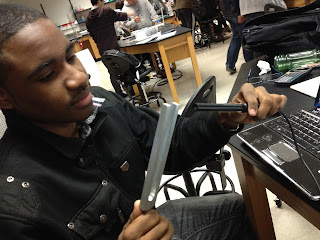In this experiment we will observe how lenses behave under certain situations. We began by getting a lens from a box but the focal length was unknown so we had to measure it. When we measured the focal length we used the sun as an infinite light source and measured the distance from the lens to the focal point observed on the ground. We observed that the focal length was 9.5 cm
+ 0.3 cm.
 |
| Measuring the Focal length |
Once we obtained the focal length. We placed the lens four focal lengths away and observed the image that was projected by it. This distance was 38.0 cm + 0.2 cm. The distance of the image from the lens was measured to be 19.0 cm + 0.2 cm. The height of the filament remained the same throughout the experiment but it was measured to be 8.8 cm + 0.1 cm. The image height was measured to be 4.4 cm + 0.1cm. From this information we can determine the magnification of the lens at this distance. The formula for magnification is, M = h_i/h_0, or M = -d_i/d_0 where h_i is the height image and h_0 is the height of the object. d_i in this formula is the distance from the lens to the mirror and d_0 is the distance from the light source to the lens. When we calculated all of our magnifications we used the ratio of the different heights. M = 0.50 + 0.2 from this trial. The magnification lower than 1 provided a sharper image. The was inverted and it was a real image. When the lens was reversed the results were the same, it remained inverted and real. The error obtained from these measurements was determined by how inaccurate we believed our measurements to be. In the calculation for magnification we added the errors together from the previously measured objects. This process was used for error analysis throughout the entire lab.
 |
| Magnification at 0.50 |
In the next trial we moved the lens so that it was two focal lengths away. This distance was 19.0 cm
+ 0.2 cm. The distance to the image from the lens was 26.0 cm
+ 0.2 cm. The height of the image was 14.5 cm
+ 0.1 cm. The magnification was calculated to be 1.648
+ 0.2. Because the magnification was larger than 1, the image appeared less focused. The image was also inverted and real in this trial. When the lens was reversed the results were the same.
Next we then moved the lens one and a half focal lengths away from the filament which was 14.3 cm
+ 0.2 cm. The distance measured from the lens to the image was 23.45 cm
+ 0.2 cm. The height of the image was measured to be 16.5 cm
+ 0.1 cm. The magnification calculated from this trial was 1.875. The image was inverted and real and appeared to be unfocused because of the magnification. We also covered the lens halfway with masking tape and observed the differences. It uses the remaining lens to project the image. The image was still completely projected onto the whiteboard but it was dimmer than the previous image because there is less lens for the light to go through.
 |
| Magnification at 1.875 |
 |
| Masking tape at 1.875 magnification |
We repeated this process two more times. The distance used was three times the focal length.
d_0 = 28.5 cm + 0.2 cm, d_i = 16.5 cm + 0.2 cm, h_0 = 8.8 cm + 0.1 cm. h_i = 6.6 cm + 0.1cm.
M = 0.75 + 0.2. The image was inverted and real.
 |
| Magnification at 0.75 |
The next trial we used the distanced to be five times the focal length.
d_0 = 47.5 cm + 0.2 cm, d_i = 16.5 cm + 0.2 cm, h_0 = 8.8 cm + 0.1 cm, h_i = 3.3 cm + 0.1cm.
M = 0.375 + 0.2. The image was again inverted and real.
 |
| Magnification at 0.375 |
On our last trial we moved the the lens to half of its focal length. When we moved it to 4.25 cm
+ 0.2 cm the image was no longer visible. The image could only be seen through the lens and was not inverted.
After all of the trials the data was graphed the first graph is d_i vs d_0.
The next graph we created was the inverse of d_i vs. the negative inverse of d_0.
The slope of this graph is 1.5984 and the y-int 0.1225. The y-int represents the length of the virtual image that is created.
Conclusion
When the lens was placed at different distances from the filament it different effects on the image. When the lens was in between 1 and 2 focal lengths the magnification was greater than one which made a bigger, less focused, image. When the lens was placed further than 2 focal lengths,the magnification was less than one and it produced a much sharper image. When the images were real, they were inverted. The image was virtual when the lens was placed at half of the focal length and would be virtual if it is placed at a distance under the focal length.


























